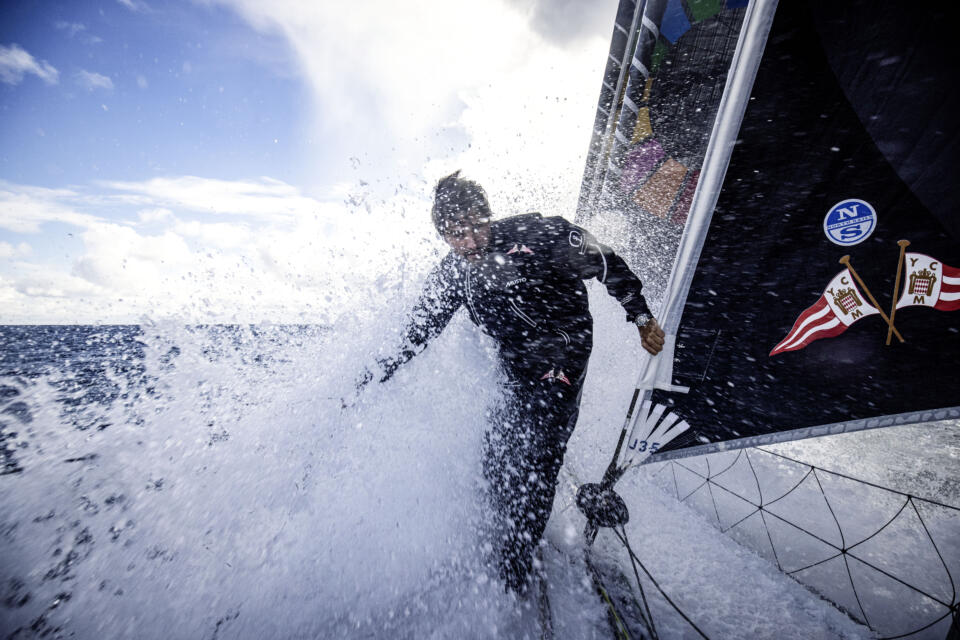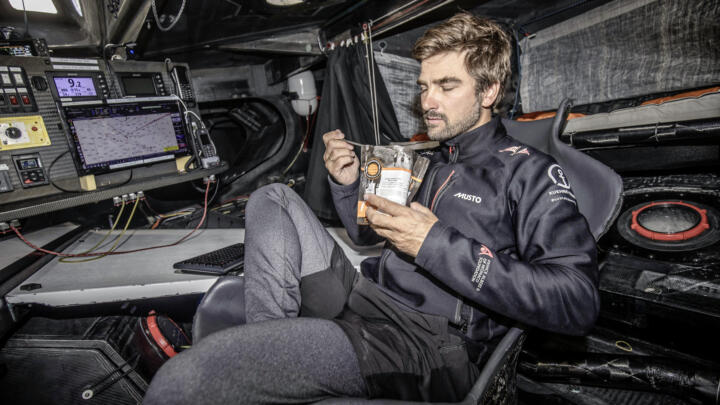
Wind of Change
24/7 agility
The wind whips the sea spray across the boat. Somewhere in the middle of nowhere, south of the 40th parallel, Boris Herrmann’s Seaexplorer is tossed around by high waves in the “Roaring Forties.” That’s what sailors have dubbed the dreaded area in the Antarctic Ocean that the Vendée Globe front runners have reached after roughly three weeks. That the professional ocean sailor from Hamburg stoically stays the course in the roaring waves may sound to landlubbers just about as impossible as nailing jelly to a tree. To the circumnavigators tackling the Vendée Globe in November 2020 it doesn’t. The 33 women and men are accustomed to defying the whims of the sea. Spending weeks on end in solitude on the oceans, ready to act 24/7, solo sailors have to make decisions to the beat of the waves confronted with “Roaring Forties,” light breezes and veritable lulls, treacherous currents and potential collisions with flotsam and mighty marine mammals – or with fishing boats. Boris Herrmann collides with one of them at nighttime in the Bay of Biscay, 90 nautical miles before the finish. None of his umpteen warning systems has emitted a beep, so the two boats collide. The crash doesn’t leave Herrmann shipwrecked, so he goes on to finish the race with the mortally wounded Seaexplorer at reduced speed. After 80 days at sea, the skipper himself has more than pushed his limits as well, especially since the last-minute incident has washed overboard his stimulating thoughts of potentially claiming victory.
80 days without stopping. Constant mental and physical agility, day and night. Pondering options and making choices, observing and musing. That pushes the limits even of first-rate athletes in top shape like Herrmann. The slightest mistake or a brief moment of inattentiveness spell danger. Shipwrecked sailors are not uncommon in the Vendée Globe. In all nine competitions combined, dozens of entrants have been forced to retire. The DNF rate is nearly 50 percent and some of the sailors did not survive the race. Boris Herrmann has mastered the Everest of the Seas, as the Vendée Globe is sometimes called. It’s a challenging balancing act between adventure, a research project and a race. “I may be reminding myself to be more cautious in one instant and, a moment later, not be willing to lose any miles. I’m engaged in a permanent internal dialog. I keep grinding until I’m on my last legs, try to sleep, try to eat, but I constantly have to deal with questions like: wouldn’t the third reef be better?” Herrmann reported during the regatta.
You’re thinking about something all the time, that permanently occupies the mind
Boris Herrmann

The most crucial question that keeps coming up for him is “what am I going to do when?” In management seminars of the business world, this is known as an in-basket exercise: setting priorities, being flexible, keeping a cool head, making the right choices to prevent shipwrecking. Boris Herrmann didn’t wreck his ship. Because he pushed his limits, like on that day at nightfall during the first half of the race when he’s forced to climb the near-30-meter (98-foot) mast to loosen a defective mount in spite of his intense fear of heights. Solo sailing is also a continuous inner battle against oneself.

© Yvan Zedda
Trim is solely the sailor’s choice
Solo sailors perform a large part of their work on computers in the rotatable control center that looks like an aircraft cockpit. This is where the sailor downloads weather data twice a day, and checks and programs the navigation software. By contrast, the manual work of sail trimming (grinding), just like calculating the course, is strictly the sailor’s job. The regulations prohibit external help. Although the technical gadgets make life easier for Herrmann, they won’t make any decisions for him. Hermann still has to choose the right sail setup himself based on wind force and swell. A solar system and hydrogenerators supply the electric power for the on-board electronics. The hydrogenerators are reminiscent of outboard engines that, like small rear turbines, are pitched into the water current and produce energy – carbon-neutral energy of course. State-of-the-art radar systems, a hermetically sealed crash box, two survival suits and two inflatable life rafts provide safety. However, a specially tailored seat that equalizes all of the boat’s movements ranks at the top of the list of the modifications on board, according to Herrmann: “I can sit there, watch the monitors, eat and when the boat moves around a lot it’s simply the best place to wedge yourself in – it doesn’t take a lot of physical exertion to stay put,” he says.
Facts and figures
A floating mini lab
The Vendée Globe provided joy not only to sailing enthusiasts but climate scientists rejoiced as well. First of all, about the safe arrival of the sailors and then about the wealth of new data collected that are normally hard to come by. Although container ships with measurement equipment on board supply data, too, they usually navigate the same routes over and over. By contrast, the Vendée Globe takes the contenders through the Antarctic Ocean and the southern Atlantic, which are still blank areas on the carbon map. To change that, a piece of measuring equipment on the Seaexplorer continuously logs data about the water’s CO2 and salt content, and temperature.
The purpose-built, energy-saving mini ocean lab that tips the scales at merely 17 kilos (37 lbs) – costing approx. 50,000 euros – is connected to a water circuit in the boat’s keel through which seawater continuously flows. “The readings are logged every 20 seconds,” said Peter Landschützer from the Max Planck Institute for Meteorology in Hamburg in an interview with the German news magazine Der Spiegel. The oceans, he explained, are an important indicator of climate change processes because they store a substantial amount of the carbon dioxide from the atmosphere. Precisely speaking, about 25 percent of anthropogenic carbon emissions. If they didn’t, global warming would be even more severe. Every ten days, Boris Herrmann would send data to the scientists at home per satellite transmission. The readings were uploaded into the SOCAT (Surface Ocean CO2 Atlas) database, which is an incredible data record of the global carbon cycle. Initial analyses have already been made and one of them says that the Antarctic Ocean stores comparably more carbon than other oceans – an exciting trend, Landschützer says, that merits more detailed investigation. In a manner of speaking, Boris Herrmann’s mission was just the starting signal to an ultra-marathon: the fight against climate change and education is one key to it in Hermann’s book. The Ocean Challenge school project co-developed by his team, Malizia, with worldwide school partnerships is a matter close to Herrmann’s heart that he plans to pursue even after the Vendée Globe. A new, super-innovative and sustainable yacht is already in planning, too. The adventure continues.
The Seaexplorer – packed with sensors

Facts & figures
| Launch | August 2015 |
| Length | 18.28 m (60 ft) |
| Width | 5.70 m(19 ft) |
| Draft | 44.50 m (15 ft) |
| Weight | 7.6 metric tons (8.4 short tons) |
| Mast height | 29 m (95 ft) |
| Windward sail areae | 290 m² (3,120 sq ft) |
| Vorwind-Downwind sail area | 490 m² (5,275 sq ft) |
| Speed max. | 40 knots (nearly 75 km/h; 47 mph) |
Power napping at sea
When do you get to sleep during a 24/7 mission? On 80 and more days in a row? The Vendée Globe sailors’ solution is extreme power napping, a sleeping strategy that used to boost even Leonardo da Vinci’s creativity. The universal genius purportedly slept only 15 minutes every four hours. And dolphins use an exciting method as well: they let just one of the hemispheres of the brain go to sleep and keep the other one on stand-by. Regatta pro Boris Herrmann sleeps a maximum of 60 minutes at a time per day during the Vendée Globe. However, these morsels add up to a total of six hours per day.
The Vendée Globe is a race we would like to win, the race against climate change is the one we must win!
Maxim of Boris Herrmann’s Malizia team
Sleep expert Dr. Holger Hein has been decoding Herrmann’s “internal clock” for more than 20 years: After many small periods of rest, Boris Herrmann is typically about as refreshed as anyone else after a normal night’s rest, he told the Hamburger Abendblatt newspaper, because even normal sleep is frequently dissected by brief, usually non-remembered wake phases. “So, ultimately, Boris didn’t do anything differently than all of us. It’s just that he didn’t continue sleeping right away like we do during a normal night.” Much more important than sleeping through the night is the depth of sleep and therefore its regenerative effect, Hein explains. That’s why Boris Herrmann has trained himself to zone out as soon as he closes his eyes. Hein classifies this gift in the “Owl” category because owls are a lot more flexible when it comes to their sleep patterns than the classic early riser. One of Hermann’s training methods while driving a car is actually taking a nap when the traffic lights turn red and having the honking horns of the cars behind him wake him up. Now who else could have come up with an idea like that …
500 years of circumnavigation
The first trip around the Earth started in 1519. The sailing expedition begun by Ferdinand Magellan took three years. Today, it takes the International Space Station (ISS) 92 minutes to circle our planet.







